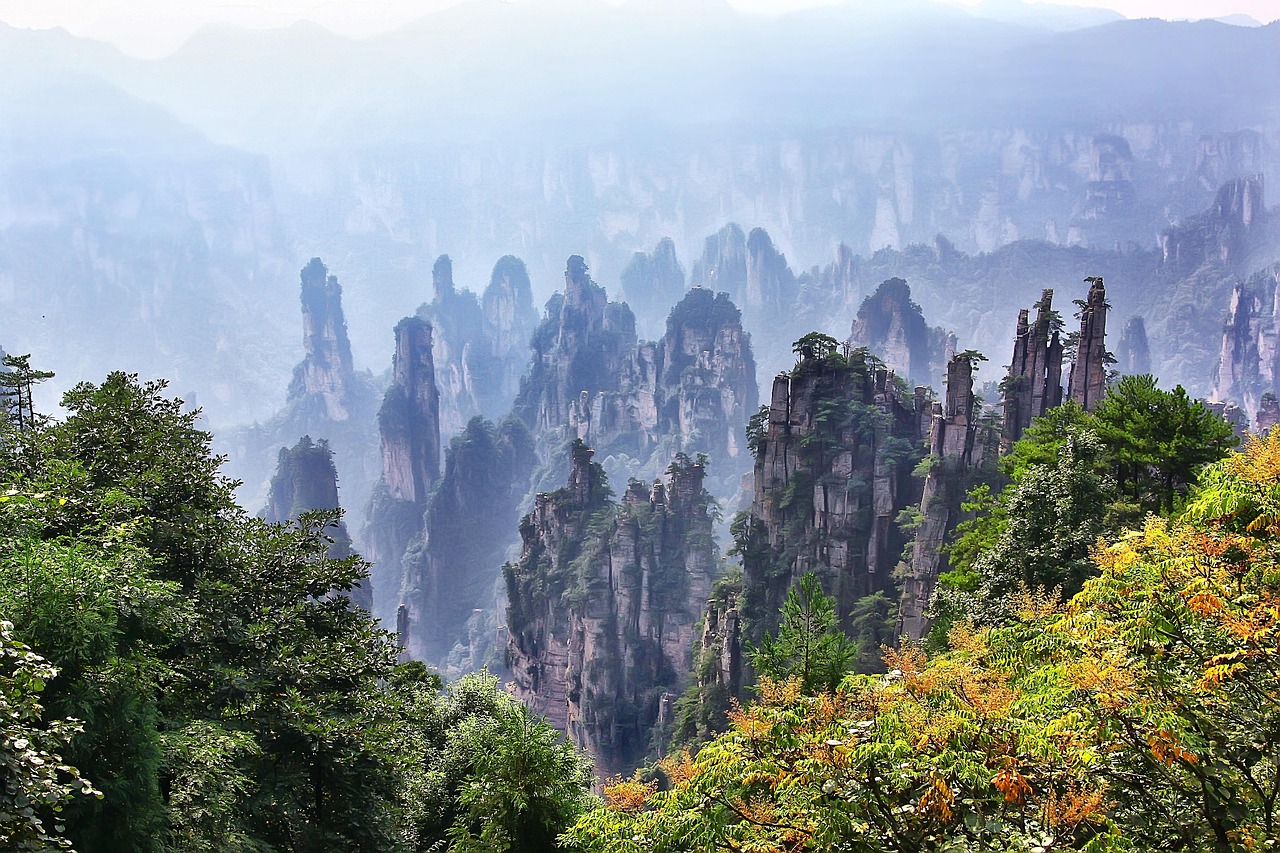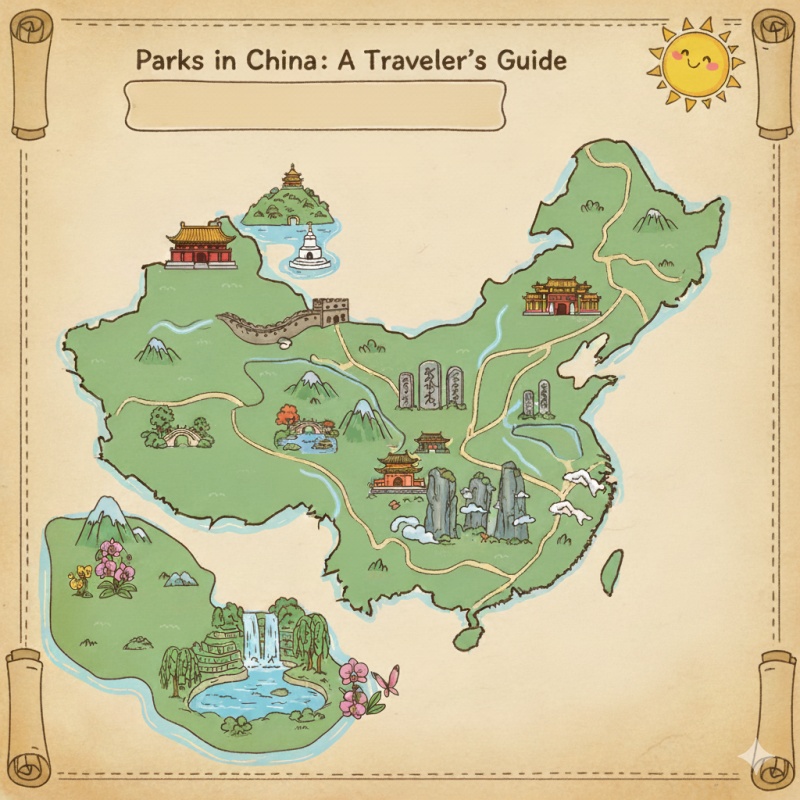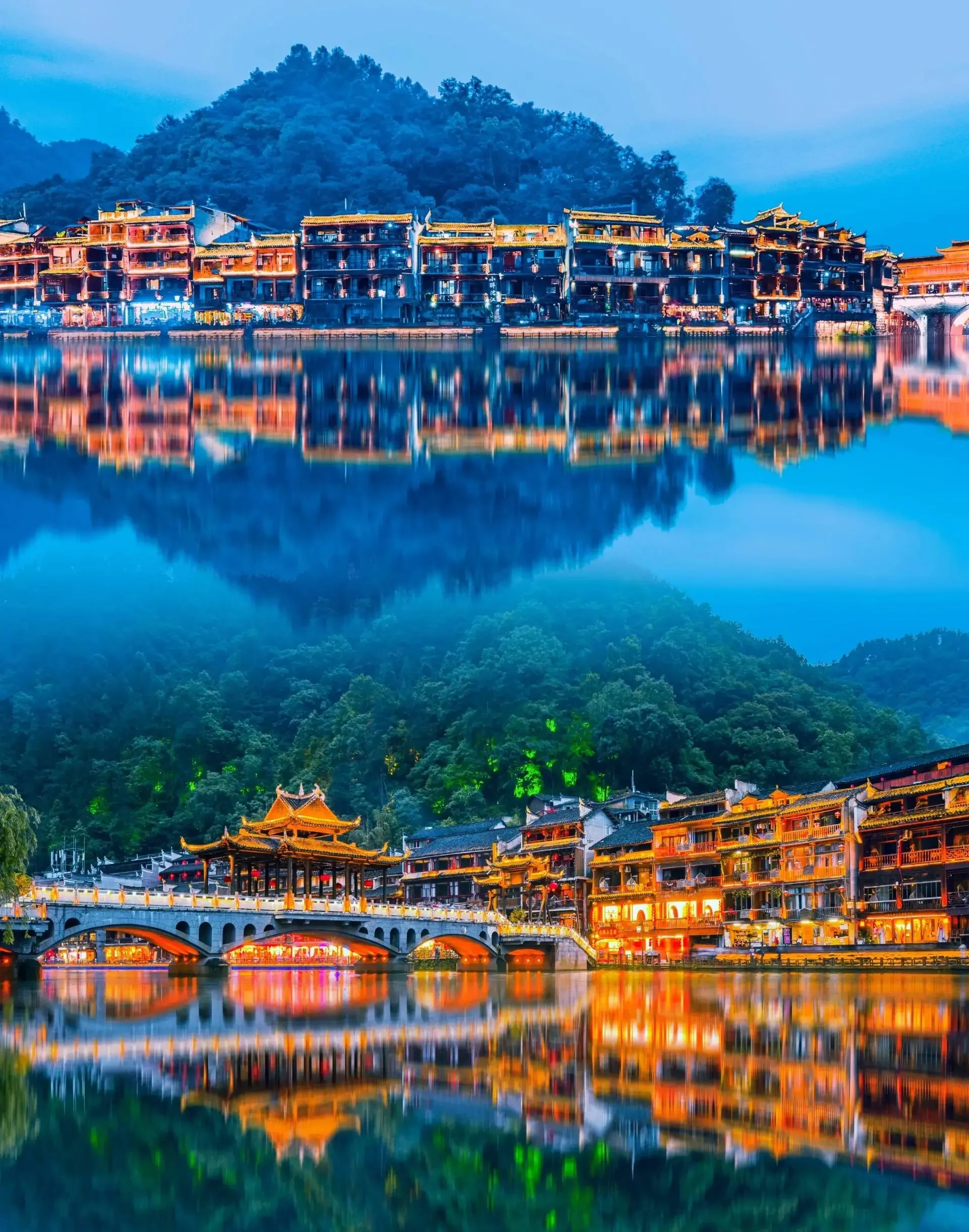Ever since Avatar hit the big screen, travelers have searched for the real-life floating mountains of Pandora. Turns out, they’re not in outer space—they’re right here in Zhangjiajie, China. The towering sandstone pillars of the Wulingyuan Scenic Area, especially those in Yuanjiajie, look almost too surreal to be real. Covered in mist and rising straight from the forest floor, they became the direct inspiration for the film’s iconic Hallelujah Mountains.In fact, one of these pillars is now officially named “Avatar Hallelujah Mountain,” drawing fans and hikers from all over the world. The entire region—home to over 3,000 narrow quartzite peaks—is a UNESCO World Heritage Site and one of China’s most breathtaking national parks.If you're planning to visit the Avatar mountains Zhangjiajie made famous, this guide shows you where to go, how to explore each scenic zone, and what to expect on the trails. Pandora isn’t as far as it seems—it’s just a hike away.
Planning your trip? Here’s a Zhangjiajie itinerary with routes and tips to keep things simple.
Are the Avatar Mountains Real?The Connection Between Zhangjiajie and the Film

James Cameron’s Inspiration from Zhangjiajie
Where is Zhangjiajie Located?
Zhangjiajie sits in northwestern Hunan Province, right where China’s Wuling Mountains rise. It’s not a megacity like Beijing or Shanghai, but its unique karst topography makes it a true standout. The region’s stone pillars and dense forests are part of a rare geological zone known as quartz sandstone landforms, formed over millions of years.
Getting there is easier than you might think. You can fly into Zhangjiajie Hehua International Airport, which has direct routes from Beijing, Shanghai, Guangzhou, and even Seoul or Bangkok. High-speed trains also link Zhangjiajie with Changsha, and long-distance buses run daily from nearby cities. Once in town, local transit (or taxis) can get you to Wulingyuan Scenic Area, the main zone to explore the so-called Avatar mountains.
How to Plan an Avatar-Inspired Itinerary
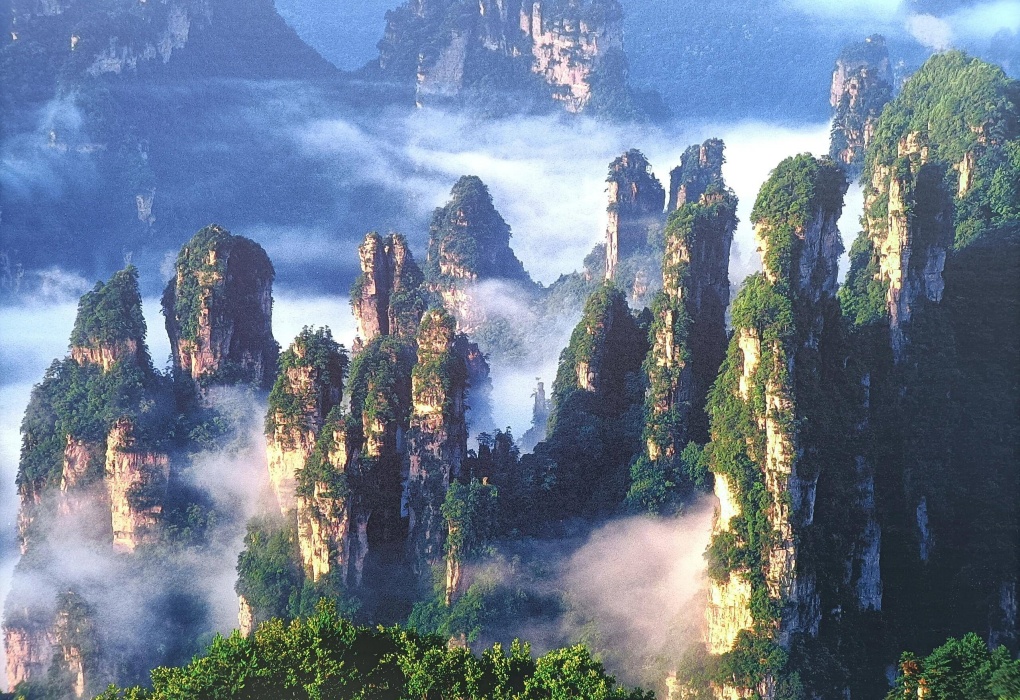
Zhangjiajie: The Inspiration Behind Avatar’s Hallelujah Mountains
Suggested 3-Day Travel Plan
If you’re short on time but big on sights, this 3-day plan gets you close to the best of the Avatar mountains Zhangjiajie has to offer.
Day 1, start with Tianmen Mountain. It’s right by the city and features a world-record cableway, cliff-hugging glass walkways, and the iconic Tianmen Cave. This warm-up hike gives you epic views with minimal effort.
Day 2 is all about Wulingyuan. Take the eco-bus to Yuanjiajie, home to the real-life Hallelujah Mountain, plus famous spots like First Bridge under Heaven. Ride the Bailong Elevator (¥72, Trip.com链接) to skip steep trails. Then walk along the Golden Whip Stream, a peaceful forest path surrounded by vertical cliffs and monkeys. Bring snacks—food options inside are limited.
Day 3, head to the Zhangjiajie Grand Canyon. This includes the glass bridge, the highest and longest of its kind. It’s not just a photo op—the thrill is real. If time allows, try the nearby cave tour or go rafting. This itinerary balances sightseeing with physical activity, so pace yourself and wear comfy shoes.
Where to See the “Avatar” Landscape
When people picture the Avatar mountains Zhangjiajie made famous, they usually mean Yuanjiajie Scenic Area. This is where you’ll spot the sandstone pillar officially renamed “Avatar Hallelujah Mountain”. The best views are from the viewing deck near the First Bridge. Come early for fewer crowds and clearer skies—mornings offer the best chance for misty, movie-like views.
To reach the top easily, use the Bailong Elevator, a glass lift built into a cliff. It gets you to 300 meters above ground in 2 minutes—fast and scenic. From there, follow the signs to photo spots. You’ll often hear guides say, “This is the real Pandora.”
“The cliffs looked like a fantasy, but the paths made it feel real. I wasn’t just looking at a movie scene—I was walking through it.”
Her words reflect what many feel here: you’re not watching from afar; you’re inside the scene. The stone towers surround you, and each step opens a new angle. Take your time—spots like Lost Souls Platform and Back Garden offer different views, and light shifts constantly.
Don’t rush this part. Even with a map, the trails twist and loop, but that’s part of the charm. Some sections are narrow and rocky, so wear good shoes. Keep your camera ready—the landscape changes with every turn, and no two photos look alike. This is where the magic of the Avatar mountains Zhangjiajie truly comes alive.
What Are the Main Scenic Areas in Zhangjiajie?
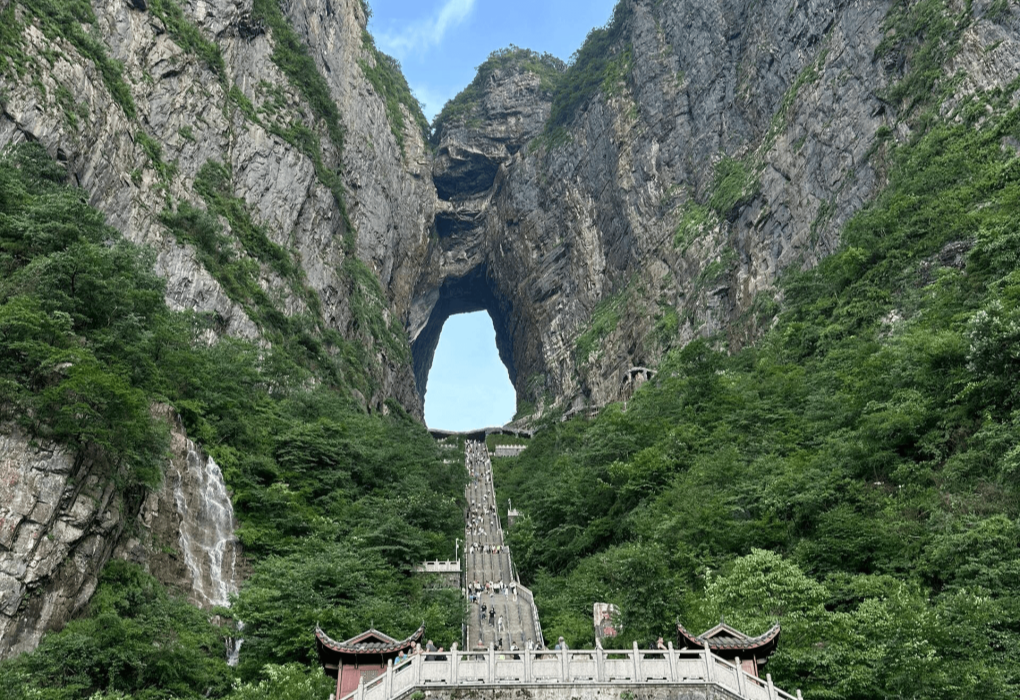
Tianmen Mountain
Wulingyuan Scenic Area
Wulingyuan Scenic Area, a UNESCO World Heritage Site, is where most travelers start their journey to the Avatar mountains Zhangjiajie is known for. The area includes Zhangjiajie National Forest Park, Yuanjiajie, Tianzi Mountain, and Golden Whip Stream, all packed with towering sandstone peaks—some over 200 meters tall. With over 3,000 stone columns covered in mist and moss, this is the place that inspired Pandora’s floating mountains in Avatar.
It’s also the section that takes the most map-checking. Wulingyuan has two major entrances: Wulingyuan Gate (east side) and Zhangjiajie Gate (southwest). The eastern gate is closer to Yuanjiajie and Tianzi Mountain, but also draws bigger crowds. That’s why many travelers book hotels in Wulingyuan town, a short walk from the gate, with plenty of guesthouses that accept foreign passports and offer local hiking advice.
Planning here is essential—don’t try to “wing it.” Trails crisscross through the forest and lead to places like Lost Souls Platform, Back Garden, and the famed First Bridge Under Heaven. The eco-bus system runs between entrances and major spots, and signs now often include English. Download an offline map beforehand, and expect lots of stairs.
Tianmen Mountain
Tianmen Mountain is not part of Wulingyuan, but it’s the dramatic welcome mat to Zhangjiajie. The mountain looms just behind downtown and offers something very different from the Avatar mountains Zhangjiajie is known for—glass skywalks, cliff-hanging roads, and temples tucked into the clouds. It’s high, holy, and full of adrenaline.
The ride up is a highlight in itself. The Tianmen Mountain Cableway is the world’s longest, stretching 7.5 km and climbing over urban streets, farmland, and cliffs in about 30 minutes. At the top, you’ll find the glass walkway, Tianmen Cave, and a 999-step staircase carved into the stone. People with vertigo—brace yourselves.
Compared to Wulingyuan, this mountain is more compact but still requires a full morning or afternoon. It’s perfect for travelers who arrive on a late-night train or have half a day to spare. Just note that summer queues can be long, especially for the cave elevator, so plan ahead and bring water.
Zhangjiajie Grand Canyon and Glass Bridge
Zhangjiajie Grand Canyon is where people go to feel tiny. This is home to the world-famous glass-bottom bridge, suspended 300 meters above the canyon floor. While it’s not part of the original Avatar mountains Zhangjiajie promoted to the world, it gives the same otherworldly vibe—especially when fog rolls in and the bridge seems to float.
This area is ideal for thrill-seekers and families alike. The bridge offers limited daily capacity, so you need to book tickets in advance. Plan to spend 3–4 hours walking across the bridge, descending into the canyon, and winding your way along the river. You can also add the limestone cave tour or mini-raft ride for an extra fee.
It’s less about hiking here and more about photo ops. Bring a hat strap, wear sneakers, and avoid carrying bulky bags—the glass panels can be slippery, especially after rain. The entrance is about 40 minutes’ drive from Wulingyuan town, so it’s best to combine this with a relaxing day or a short hike elsewhere.
How to Explore the Wulingyuan Scenic Area
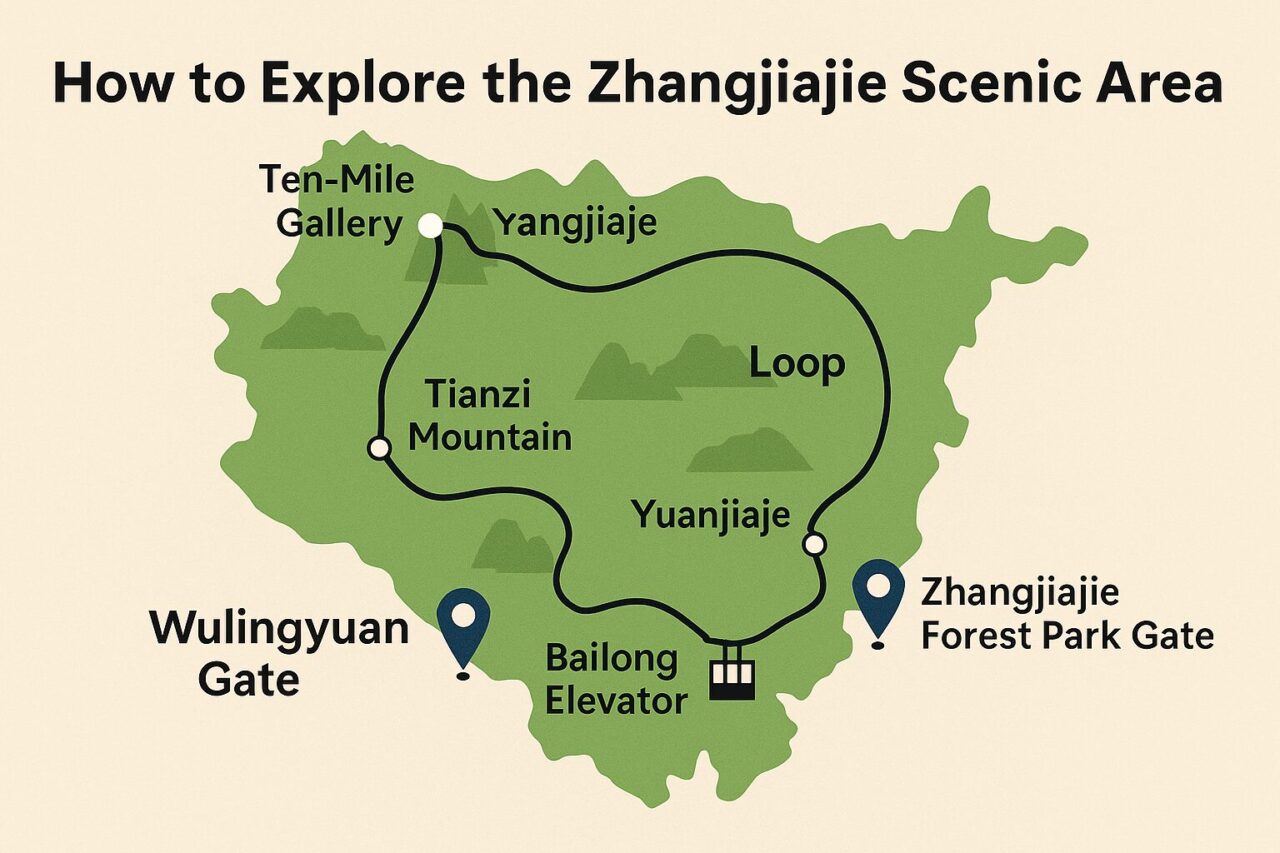
Wulingyuan Tourist Map
Choose the Right Entrance
Wulingyuan is huge, so start smart. There are two main park gates: the Wulingyuan Gate (east) and the Zhangjiajie Forest Park Gate (southwest). If you're staying in Wulingyuan town, the eastern gate is just a 10-minute walk. It gives fast access to Yuanjiajie, Tianzi Mountain, and the glass elevator. The southern gate is quieter and closer to Golden Whip Stream. Pick your entrance based on what you want to see first. If you're entering from the city, plan extra time—traffic can get slow in the morning. Make sure to bring your passport—it’s needed at the ticket check.
Use the Eco-Bus System Wisely
Once inside, don’t try to walk between major areas. Use the eco-buses—they’re fast, free with your park ticket, and easy to navigate. Buses run between scenic zones like Yuanjiajie, Tianzi Mountain, Ten-Mile Gallery, and Yangjiajie. Signs are mostly in Chinese, but the staff are used to tourists. If unsure, show your map or photo of the destination. Some lines take 30–40 minutes—bring snacks and headphones. Always double-check which platform you’re boarding from. Trails in Wulingyuan don’t loop—if you start hiking down, you might not want to hike back up. Use the bus to position yourself smartly, especially if you plan to catch the last ride around 6 PM.
Plan a Loop, Not a Straight Line
Don’t just wander—plan a loop route that returns to your entry point. A good one is: Bailong Elevator → Yuanjiajie → Tianzi Mountain → Cable Car Down → Eco-bus back. That gives you cliffs, sky views, and avoids walking the same trail twice. Another popular loop: Ten-Mile Gallery → Yangjiajie → Tianzi—best for second-day hikes. Most areas have signs and arrows, but don’t count on GPS—it often fails deep in the forest. Bring a paper map, or download the park’s offline map via Amap or Trip.com’s mini-program. Cell signal is patchy, so prep matters. If you're not confident with solo navigation, hiring a local guide for one day is worth it.
What’s the Cost of Visiting the Avatar Mountains in Zhangjiajie?
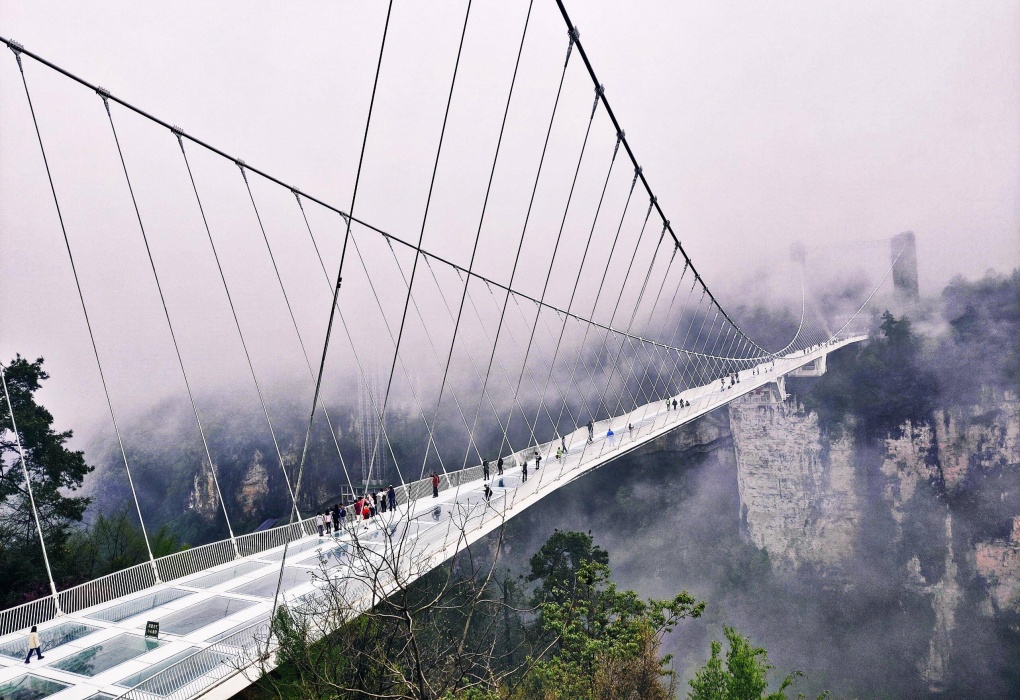
Zhangjiajie Glass Bridge
Planning your trip to the Avatar mountains Zhangjiajie? Here’s what you need to budget. Costs vary depending on which areas you visit, but the table below gives a clear overview of entrance tickets and add-on rides.
Main Entrance Tickets
| Attraction | Ticket Type | Price (RMB) | Notes |
|---|---|---|---|
| Zhangjiajie National Forest Park | 4-Day Entrance Pass | 228 | Includes eco-bus between scenic areas |
| Tianmen Mountain | Entrance + Cable Car + Shuttle | 275 | Includes glass skywalk and Tianmen Cave |
| Zhangjiajie Grand Canyon & Bridge | Full Access (Bridge + Canyon) | 219 | Includes trail and bridge |
| Zhangjiajie Glass Bridge Only | Bridge Access Only | 141 | No canyon hike included |
Common Add-On Rides
| Ride / Activity | Price (RMB) | Notes |
|---|---|---|
| Bailong Elevator (one-way) | 72 | Fastest way up to Yuanjiajie |
| Tianzi Mountain Cable Car | 67 | Round-trip, great views |
| Ten-Mile Gallery Mini Train | 38 | Optional ride through scenic valley |
| Canyon Rafting (Seasonal) | 50–80 | Optional, book on-site |
| Yellow Dragon Cave Tour | 100+ | Optional half-day cave tour |
Where to Stay Near the Avatar Mountains?
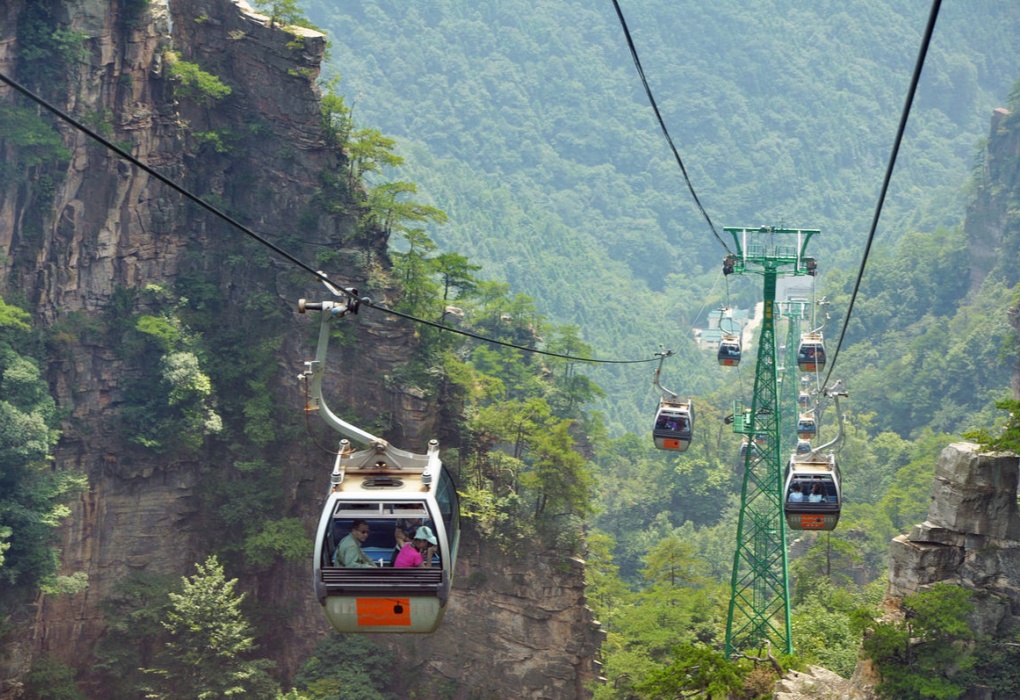
Tianmen Mountain Cable Car in Zhangjiajie
Wulingyuan Area
If your main goal is to explore the Avatar mountains Zhangjiajie from sunrise to sunset, staying in the Wulingyuan area is your best bet. This small town is located right next to the Wulingyuan Scenic Area gate, meaning you can walk to the park entrance in 5–10 minutes. Many hotels and hostels here are geared toward hikers and nature lovers, with early breakfasts, trail maps, and friendly staff.
You’ll find a wide range of options. Budget guesthouses go for 150–250 RMB/night, and many offer English-speaking front desks and accept foreign passports without issue. Mid-range hotels with better views or courtyards fall in the 350–500 RMB range. If you want a little luxury, resorts like Pullman Zhangjiajie start at around 600 RMB/night and provide tour services, private transport, and on-site restaurants.
The biggest perk of staying here? Time. You can enter the park early, beat the crowds, and even return mid-day for a nap before heading back in for sunset. Plus, Wulingyuan town has good restaurants, shops, and cafes—though note that Western food is limited.
Top tip: If you're visiting during national holidays or summer, book accommodation at least 2–3 weeks ahead. This area fills up fast, especially the places with park views or shuttle access.
Zhangjiajie City Area
Staying in Zhangjiajie city works well if you’re arriving late by train or flying in at night. The city is around 40 minutes by taxi or 1 hour by bus from Wulingyuan, so you’ll trade proximity for convenience. But the upside is clear—there’s a wider variety of services, supermarkets, and international food options.
This area is ideal for your first or last night, especially if your flight lands late or you have an early departure. Hotels near the Zhangjiajie Hehua International Airport or Zhangjiajie Railway Station often offer airport pickups, and many are familiar with foreigner check-in procedures. You’ll also find reliable Wi-Fi, 24-hour desks, and Western-style breakfasts in some business hotels.
Budget travelers can find decent spots for 120–200 RMB/night, while modern chains like Vienna, Holiday Inn Express, or Hampton by Hilton go for 300–500 RMB. These are clean, safe, and accept foreigners. While you won't wake up next to a sandstone pillar, it’s a practical way to settle in before hitting the Avatar mountains Zhangjiajie the next day.
Good to know: If you’re staying here and plan to visit Wulingyuan the same day, leave before 7:30 AM to beat traffic and maximize your park time.
Tips for Foreign Visitors to Zhangjiajie
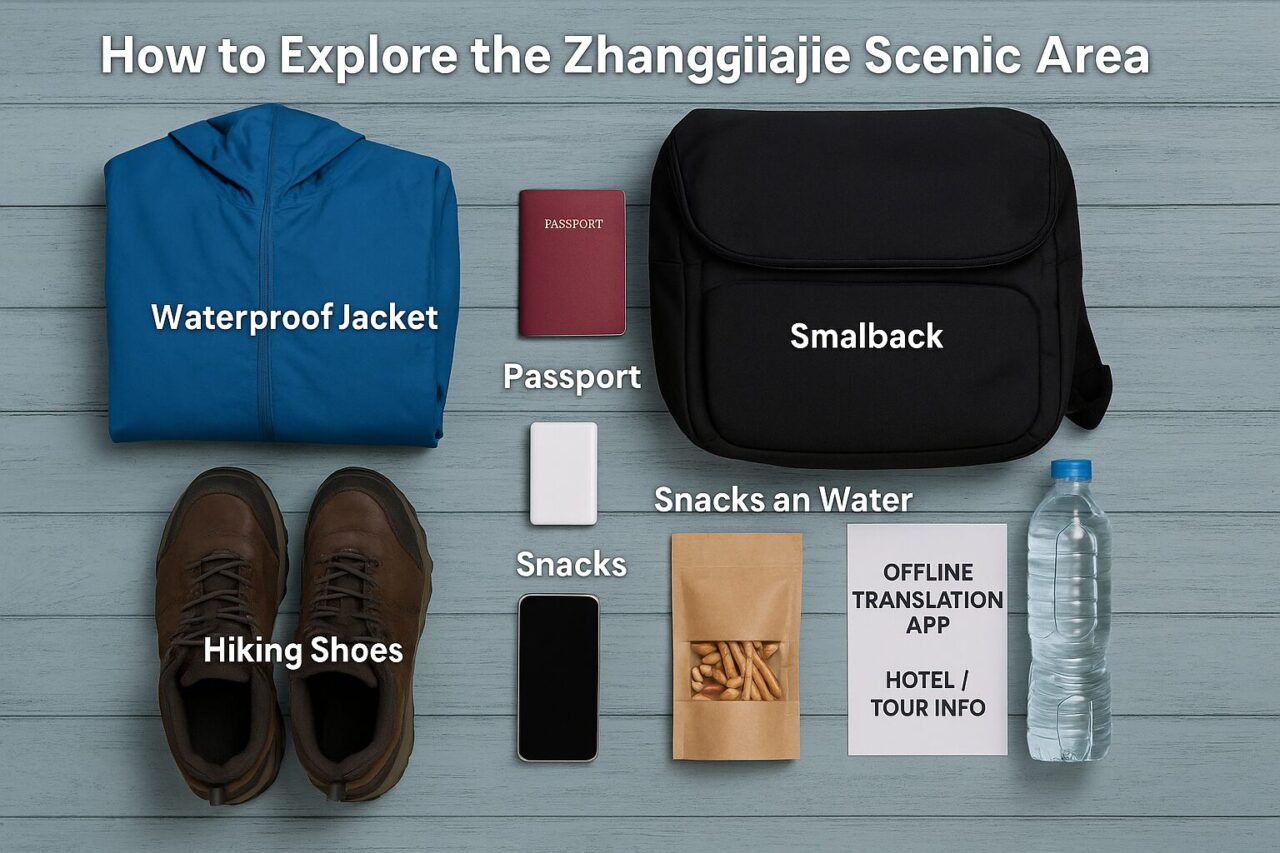
Things to Bring When Visiting Zhangjiajie
Language and Communication
Let’s be real—English is limited in Zhangjiajie. While staff at major hotels or Trip.com-supported spots may speak basic English, most locals in restaurants, ticket booths, or shops won’t. Don’t panic though—technology is your friend here.
Download a translation app like Google Translate or iTranslate, and preload Chinese labels for major sites, like “张家界国家森林公园” (Zhangjiajie National Forest Park) or “武陵源” (Wulingyuan). Having screenshots of hotel addresses in Chinese is also a lifesaver when showing taxi drivers. Many tourists also use Pleco for offline dictionary help, and Baidu Translate handles image-based translation quite well for menus or signs.
A few Mandarin phrases go a long way. Learn how to say “I want to go to...” (我要去...), “How much?” (多少钱?), and “thank you” (谢谢). Locals are generally kind and patient, and if you show a little effort, they’ll often meet you halfway.
Booking Tickets and Getting Around
One golden rule: don’t wait until the last minute to book. While Zhangjiajie isn’t Disneyland, tickets for places like the Glass Bridge or Tianmen Mountain cable car do sell out, especially during weekends and holidays. Use platforms like Trip.com that offer English-language interfaces and international payment options.
As for transportation, public buses connect Zhangjiajie city to Wulingyuan for about 20 RMB, and taxis cost around 80–100 RMB. Within scenic areas, most long distances are covered by eco-buses, included in your main park ticket. But rides like Bailong Elevator (72 RMB) or Tianzi Mountain Cable Car (67 RMB) cost extra and should be added to your plan if you want to skip long hikes.
A helpful tip? Save a screenshot of the Zhangjiajie park map in Chinese and English. The layout can be confusing, especially with multiple trails, shuttle routes, and scenic zones.
What to Pack?
Weather in Zhangjiajie is unpredictable—sunny one minute, rainy the next. Bring a light raincoat or poncho, and avoid umbrellas (they’re useless on mountain trails). Comfortable hiking shoes are a must. The terrain includes steep steps, damp rocks, and muddy paths.
Other must-haves:
- Passport (needed for hotel check-ins and some ticket verification)
- Power bank (you’ll take more photos than expected)
- Snacks and water (park food is overpriced or hard to find)
- Small backpack (lockers are rare inside the park)
- Offline translation app and paper copy of hotel/tour info
One underrated tip? Pack cash, at least 200–300 RMB, in case a vendor doesn’t take Alipay, WeChat Pay, or card. Foreign cards often don’t work outside major hotels or airports, and currency exchange counters are scarce.
Frequently Asked Questions (FAQs)
Q: Can I visit Zhangjiajie without joining a tour?
Yes, you can absolutely explore Zhangjiajie on your own. Just plan carefully. Most travelers use Trip.com to book tickets in advance. It supports English and works well for foreigners. You don’t need a guide, but having offline maps really helps. The park layout can be confusing if you’re unprepared. Signs have some English, but not always. Eco-buses take you between major scenic spots. For airport or train station transfers, taxis are easy to get. Some hotels even help arrange pickup. If you’re confident using apps and don’t mind figuring things out, going solo is totally doable. Just avoid holiday crowds and check weather forecasts daily. You’ll want to carry cash, trail snacks, and a screenshot of key Chinese names. This place rewards slow travel. Go at your own pace and take time at each spot. It’s not about checking boxes—it’s about being there.
Q: Is the Glass Bridge scary for people with a fear of heights?
Yes, it can feel intense—but it’s not dangerous. The bridge sways slightly, and the glass gives full views below. If you’re nervous, avoid windy days. Mornings tend to be calmer and less crowded. Staff limit the number of people on it at once. You can walk along the side for more stability. Some people walk quickly across, others take photos mid-way. No shame in holding the railing. There’s an exit after the bridge if you don’t want to hike further. I’ve seen people scared stiff at first who later laughed about it. But if you have serious vertigo, skip it and explore the canyon from below. The hike’s beautiful even without the glass. Just know the bridge is shorter than most expect—it’s thrilling but over quickly. If heights stress you out, there’s no pressure to cross.
Q: What’s the best time of day to enter the park?
Early morning is hands-down the best time to enter. Try to arrive before 8:30 AM. You’ll beat the crowds and catch misty mountain views. Lighting is softer then—perfect for photos. By mid-morning, tour groups start pouring in. Queue times grow longer for shuttles and elevators. If you want peace, go early and start with Yuanjiajie or Golden Whip Stream. Around noon, take a break outside or return to your hotel. Re-enter in late afternoon when crowds thin again. Sunset views from Tianzi Mountain are incredible. Just remember your ticket is valid for multiple days. Use that to your advantage. Split your hikes between morning and evening. Avoid the noon heat in summer. Also, check park opening times—some gates open earlier than others. If you’re staying nearby, walking to the gate at sunrise is magic.
Q: Are there luggage storage options near Zhangjiajie scenic areas?
Yes, but only in select places—not everywhere. Most larger hotels offer storage if you check in or out that day. Near park entrances, a few small shops rent lockers or hold bags. Wulingyuan Gate has more choices than the city gate. Expect to pay around 10–20 RMB. Still, don’t count on lockers inside the park. Once you're in, it's mostly stairs, trails, and forest. Carry only what you need: water, snacks, rain gear, and camera. If you're coming straight from the train or airport, store your luggage in the city first. The train station has a manned counter; just show your passport. Or ask your hotel—they’re usually happy to help. Better to pack light and keep your hands free. You’ll enjoy the cliffs and trails a lot more that way. Heavy backpacks ruin the hike fast, especially with steep climbs.
Q: Can I use foreign credit cards at Zhangjiajie attractions?
Not easily, and that’s a common issue. Most park counters and small vendors only take Alipay, WeChat Pay, or local cards. Foreign cards rarely work at ticket offices or inside the park. That’s why booking on Trip.com is a huge help—they accept Visa, Mastercard, and PayPal. Bring cash for snacks, small items, or taxis. Many food stalls don’t even try to process foreign cards. Hotels and chain restaurants in the city might take them, but don’t count on it. If you want to try using mobile payments, get help setting up WeChat Pay linked to a foreign card—it works in most places once verified. Still, always have backup cash in your bag. ATMs can be tricky too—some reject foreign cards outright. Avoid surprises and pay online where possible. In Zhangjiajie, mobile and cash beat plastic every time.
Q: What local dishes should I try while staying in Zhangjiajie?
Zhangjiajie food is spicy, smoky, and full of bold flavor. Locals love preserved chili, garlic, and pickled vegetables. One must-try is sour fish hotpot—a mix of freshwater fish, cabbage, and spice. Also try tuotuo rice (round sticky rice portions) and wild mountain veggies sautéed in lard. If you eat meat, the smoked bacon stir-fried with garlic stems is incredible. It’s salty, fatty, and super local. Breakfast is often simple—sticky rice or fried dough with warm soy milk. Western food exists, but it’s basic: pizza, toast, maybe pasta. If you're picky, stick to hotel cafés or pack snacks. Menus often have photos, but not English. Use a translator app, or point to the next table. Street food is safe if freshly cooked—grilled tofu, barbecued lamb, and fried rice noodles are solid bets. If you're adventurous, ask for something “bu tai la” (not too spicy).
Q: Is hiking in Zhangjiajie suitable for beginners?
Yes, but know your limits. Zhangjiajie has trails for all levels. The eco-buses drop you close to most main viewpoints, so you can avoid steep uphill climbs if needed. Some areas, like Golden Whip Stream, are almost flat and great for casual walking. Trails like Tianzi Mountain or the canyon paths involve stairs—lots of them. If you have knee issues, use walking sticks or take cable cars when available. The Bailong Elevator is perfect for skipping long ascents. Wear shoes with grip—the stone steps can get slick, especially after rain. Don’t feel pressured to “see it all.” Choose one or two areas per day. Rest often, stay hydrated, and don’t chase group tours. Zhangjiajie isn’t a race. You’ll enjoy it more if you slow down and focus on the views. Even first-time hikers say the scenery makes every step worth it
Want more China travel ideas? Check out our city guides on Beijing, Shanghai, Guangzhou, and Chengdu.
